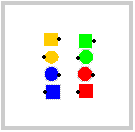
restart
Nancy Rogers and Michael Buchler,
Square Dance Moves and Twelve-Tone Operators
Figure 14. Animation of "swing through," iterated twice.
|
Dancers holding right hands rotate 180 degrees clockwise (described in square
dancing terms as "swing half by the right"). |
| STn = Swing through iterated n times. For any wave of length n: STn = original wave [ T0 ] STn/2 retrogrades the initial wave [ R(T0) ] |
Example: ST0 = < 0, 1, 2, 3 > ST1 = < 1, 3, 0, 2 > ST2 = < 3, 2, 1, 0 > ST3 = < 2, 0, 3, 1 > ST4 = < 0, 1, 2, 3 > = ST0 |
We might be tempted to view "swing through" as a combination of Lewinesque contextually-defined functions FLIPENDS followed by FLIPMIDDLE. However, this would not be altogether accurate. Callers occasionally navigate the dancers into a sort of inverted position called a "left-handed wave," in which the outer dancers touch left hands and the inner dancers touch right hands. Because of the way it is defined, "swing through" called from this formation would entail FLIPMIDDLE followed by FLIPENDS. From a left-handed ocean wave, the most common call is a "left swing through," defined as "swing half by the left and half by the right." "Left swing through" could, of course, also be called from a standard righted-handed ocean wave, but this is exceedingly rare. |